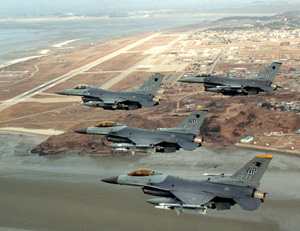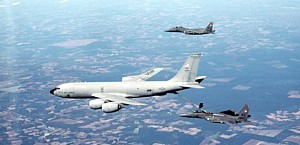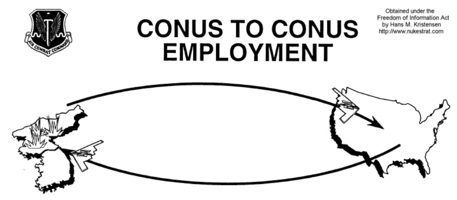Nuclear Brief September 28, 2005 (updated November 3,
2006)
U.S. Nuclear Strike Planning Against North Korea
Following the
withdrawal of non-strategic nuclear weapons from South Korea, U.S.
nuclear planning against North Korea has continued to evolve. Employment of
non-strategic bombs against the North is now the responsibility of fighter wings based in
the continental United States. Other nuclear planning involves Trident
submarines and long-range strategic bombers.
The 2001 Nuclear Posture
Review identified North Korea as an "immediate contingency" that sets
requirements for U.S. nuclear strike capabilities, and the assignment of
the
Global Strike mission to STRATCOM in 2003 led to the creation of
CONPLAN 8022, a new preemptive strike plan that has North Korea (among
others) in the crosshairs. Finally, the North Korean nuclear test in
October 2006 reaffirmed these planning requirements and triggered a
strong reaffirmation of U.S. extended nuclear deterrence policy in the
region.
|
U.S. F-16s
Over Kunsan Air Base |
 |
|
The 8th Tactical Fighter Wing at Kunsan Air Base last was certified to store and deliver nuclear
weapons in January-June 1991. |
Fighter-Bombers
The last known nuclear weapons certification
inspection of the 8th Tactical Fighter Wing at Kunsan Air Base occurred
in the first half of 1991.
The wing's history for the period January-June 1991 describes the
weapons division at the base passed special Air Force training and
inspections. These were needed for the wing to be certified to store and
handle nuclear weapons on the base.
The history also describes that U.S. pilots at Kunsan Air Base
underwent nuclear strike training. This consisted of general nuclear
strike qualification, and "single-ship nuclear strikes." A total of 48
F-16C/D aircraft were stationed at Kunsan at the time, some of which
were equipped to deliver B61 nuclear bombs stored at the base. After the
withdrawal of the nuclear weapons in December 1991, the nuclear
certification of the wing was allowed to expire.
 |
|
After the withdrawal of nuclear weapons from
South Korea in December 1991, the 4th Fighter Wing at Seymour
Johnson Air Force Base has been tasked with nuclear strike planning
against North Korea. |
Since then, strike planning against North Korea with
non-strategic nuclear weapons has been the responsibility of fighter
wings based in the continental United States. One of these is the 4th
Fighter Wing at Seymour Johnson Air Force Base in North Carolina. During
the first half of 1998, according to
the 4th FW command history, a total of 18 F-15E Strike
Eagle fighter bombers of the 336th Fighter Squadron were
scrambled ("generated") in a Nuclear Employment Exercise (NEM) that
simulated a nuclear strike against North Korea. Instead of flying to
Korea, the aircraft dropped their BDU-38 dummy nuclear bombs at the Avon
Park Bombing Range in Florida. The scenario was
described by the wing commander:
"We simulated fighting a war in
Korea, using a Korean scenario. This included [North Korean]
chemical attacks to protect against using full chemical gear
[sic]. The scenario...simulated a decision by the National Command
Authority about considering using nuclear weapons....We identified
aircraft, crews, and [weapon] loaders to load up tactical nuclear
weapons onto our aircraft....[The] last phase of the exercise, the
employment phase...required us to fly those airplanes down to a
range in Florida and drop" the BDU-38s.
This scenario was exercised twice during the period and
also formed the basis of the wing's nuclear certification inspection.
 |
|
With a capability to strike targets in less than
15 minutes, the Trident D5 sea-launched ballistic missile is a
"mission critical system" for U.S. Forces Korea. |
Ballistic Missile Submarines and Long-Range Bombers
In addition to non-strategic air delivered bombs,
sea-launched ballistic missiles onboard strategic Ohio-class
submarines (SSBNs) patrolling in the Pacific appear also to have a mission
against North Korea. A
DOD General Inspector report from 1998 listed the
Trident system as a "mission critical system" identified by U.S. Pacific
Command and U.S. Forces Korea as "being of particular importance to
them."
Although the primary mission of the Trident system is
directed against targets in Russia and China, a D5 missile launched in a
low-trajectory flight provides a unique very
short notice (12-13 minutes) strike capability against time-critical targets
in North Korea. No other U.S. nuclear weapon system can get a warhead on
target that fast. Two-three SSBNs are on "hard alert" in the Pacific at
any given time, holding Russian, Chinese and North Korean targets at
risk from designated patrol areas.
Long-range strategic bombers may also be assigned a
nuclear strike role against North Korea although little specific is
known. An Air Force map (see below) suggests a B-2 strike role against
North Korea. As the designated carrier of the B61-11 earth penetrating nuclear
bomb, the B-2 is a strong candidate for potential nuclear strike
missions against North Korean deeply buried underground facilities.
|
B-2 Strike
Planning Against North Korea |
 |
|
As the designated carrier of the
B61-11 earth
penetrating nuclear bomb and a possible future Robust
Nuclear Earth Penetrator, the B-2 stealth bomber could
have an important role against targets in North Korea.
Recent upgrades enable planning of a new B-2 nuclear strike
mission in less than 8 hours. |
The capability of the B-2 bomber to
conduct short-notice nuclear strikes has been improved in recent years.
Until the late 1990s, planning and processing of a single
SIOP (Single Integrated Operational Plan) sortie with a B-2 bomber
took approximately 25 hours. In 1998, modernization was underway for a
50 percent increase in performance by providing three times faster
hardware and software fixes. And in November 1998, STRATCOM ordered that
the Operational Requirement Document for the B-2 be updated to allow
even shorter timelines for nuclear strike missions:
a) Deliberate Planned
Missions: no more than 24 hours.
b)
Adaptive Planned Mission (Directed Planning Option and
Theater Nuclear Option): no more than 8 hours.
While this upgrade is also intended for strike planning
against targets in Russia and China, the implication is that planning
for a new limited strike sortie against North Korea could be
done in less time than it takes for a B-2 to fly from Whiteman AFB in
Missouri to North Korea.The Effect of the
2006 Nuclear Test
The future of U.S. nuclear strike planning against North
Korea has attained
new importance after Pyongyang conducted a nuclear test in October 2006.
The test triggered a strong U.S. reaffirmation of the nuclear umbrella
over South Korea and Japan, and appears to have bolstered nuclear (and
conventional) planning in the region.
"The United States will meet the full range of our
deterrent and security commitments," President
Bush told Japan and South Korea immediately after the test.
Secretary of State Condoleezza Rice traveled to Northeast Asia where she
almost spelled out the n-word,
saying that "the United States has the will and the capability to
meet the full range - and I underscore full range - of its
deterrent and security commitments to Japan." (Emphasis added.)
Two weeks later, William Arkin
disclosed that a revision of CONPLAN 5029 had begun to create
additional preemptive conventional strike options against North Korean
Weapons of Mass Destruction (WMD) activities. The Washington Times
picked up on that lead and
reported that conventional strike planning has been underway for
months before the test, but was now accelerating. Nuclear strikes were
considered excessive, a Pentagon official to the paper, but another
senior defense official reaffirmed the nuclear umbrella and the United
States "will resort to whatever force levels we need to have, to defend
the Republic of Korea. That nuclear deterrence is in place."
Implications
The United States pledged in the
Joint
Statement of the Fourth Round of the Six-Party Talks on September
19, 2005, that it "has no intention to attack...[North Korea] with
nuclear...weapons." To the extent that continued nuclear strike planning
represents an "intent" to attack, however, such planning contradicts the
Joint Statement.
|
North Korea
In Current Planning |
|
On November 18, 2005, the new Space and Global
Strike command became operational at STRATCOM after passing
testing in a nuclear war exercise involving North Korea. See
background. |
Current U.S. Nuclear strike planning against North Korea
appears to serve three roles: The first is a vaguely defined traditional
deterrence role intended to influence North Korean behavior prior to
hostilities. This role was broadened somewhat by the 2001 Nuclear
Posture Review to not only deter but also dissuade North Korea from
pursuing weapons of mass destruction. Why, after five decades of
confronting North Korea with nuclear weapons only to see Pyongyang
deepen its pursuit of weapons of mass destruction, the Bush
administration believes that additional nuclear capabilities will
somehow dissuade North Korea from pursuing weapons of mass destruction
is a mystery. It is even more so because
the 1994 Nuclear Posture Review concluded that the removal of
nuclear from South Korea and ships around the peninsula did not impact
proliferation.
The second role is assurance, persuading South Korea
and Japan that the United States has the capability and will to defend
them against a North Korean attack. Washington is concerned about the
possibility that Tokyo and Seoul may decide they need to build nuclear
weapons too in response to North Korea's WMD program. "I believe it is
important to have various discussions on it [possessing nuclear
weapons]," Japanese Foreign Minister Taro Aso
told a parliamentary foreign affairs panel after the North Korean
test. "The reality is that it is only Japan that has not discussed
possessing nuclear weapons, and all other countries have been discussing
it," he said. But that discussion "is already finished," Prime Minister
Shinzo Abe
quickly intervened, insisting that his newly formed government is
not split on the nuclear issue. Japan and South Korea may fear that
Pyongyang does not believe the United States would be prepared to
retaliate with nuclear weapons if North Korea attacked. But why a
Japanese or South Korean nuclear bomb would be any better in affecting
Pyongyang's calculations is unclear.
The third role is in case deterrence fails: The actual use of
nuclear weapons to ensure destruction of targets. The Cold War deployment of
hundreds of tactical battlefield nuclear weapons in South Korea
anticipated deterrence failure on a grand scale, but even though these
weapons
have now been withdrawn, nuclear battlefield planning has continued.
The Bush administration's preemption doctrine, which is partly motivated
by North Korea, is the most extreme example of this because it
anticipates that deterrence will fail. Although
STRATCOM concluded in 1993 that "classical
deterrence already allows for adaptively planned missions to counter
any use of WMD," the Pentagon has not simply
relied on existing capabilities to implement the preemption doctrine,
but argued that new and more efficient offensive "global strike"
and defensive missile defense capabilities are
needed to defeat adversaries such as North Korea.
For
other aspects of the Korean nuclear issue, see:
»
A history of U.S. nuclear weapons in South Korea
»
Withdrawal of U.S. nuclear weapons from South Korea
»
Nuclear umbrella over South Korea reaffirmed
|

